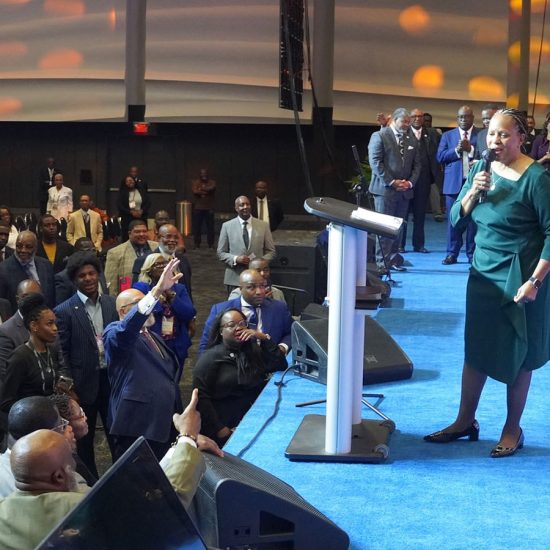

SAFE CHURCH: How to Guard Against Sexism and Abuse in Christian Communities. By Andrew J. Bauman. Grand Rapids, MI: Baker Books, 2025. 186 pages.
Every day, it seems, we hear another story of sexual misconduct or abuse taking place in a religious setting. Often these stories involve pastors/priests or some other staff member. The moral of the story seems to be that churches are not safe, especially if you are a woman. So, how might churches change this storyline? For some faith communities, that likely will involve changing the way women are perceived at a time when forms of toxic masculinity are on the rise. Faith communities can and should develop boundary training opportunities (and requirements) for church leaders, as well as develop and implement safe-church policies. It’s not just one thing, of course, because situations differ, as do possible solutions. However, churches and Christians in general will need to be aware of the problems that exist if solutions are to be found and implemented. That will prove difficult for many since women are excluded from leadership and having a voice in such matters.

Robert D. Cornwall
One who recognizes both the problems and the challenges that exist in the churches is Dr. Andrew Bauman, a former pastor and the founder and director of the Christian Counseling Center: For Sexual Health & Trauma, as well as a licensed mental health counselor. He holds a doctorate from Northeastern University. With that experience as a foundation, Bauman offers the church, especially evangelical churches, an important resource: Safe Church: How to Guard Against Sexism and Abuse in Christian Communities (Baker 2025). The subtitle reveals what to expect from the book. He addresses sexism and abuse present in Christian communities. While he writes from an evangelical perspective to a largely evangelical audience, what he writes here translates to other communities, including Mainline Churches, most of which require some form of boundary training and generally affirm the full equality of women in the church, including in leadership roles. The current and previous General Ministers and Presidents of my denomination are women. Of course, that doesn’t mean that sexism and abuse do not exist in our more “progressive” churches.
The problem Bauman names in Safe Church is that the church in general has failed women. This is revealed in the growing number of reported sexual abuse scandals involving high-profile clergy and ministry leaders, as well as news of cover-ups of sexual harassment and abuse, as seen in the Southern Baptist Convention. He writes this book as someone who once held “complementarian” views of women and their roles in the home, church, and society. Those holding this view teach that women should submit to male leaders, including their husbands, as well as limiting their roles in the life of the church, including that of serving as a pastor. While he acknowledges that women need to tell their stories, he also believes that men need to be allies, especially in settings where women’s voices have been muted. In many ways, this is a book that speaks to men.
Andrew Bauman’s book Safe Church is composed of eleven chapters. He begins this effort in Chapter 1 with an overview of the problem of sexism and abuse within Protestant churches. While women have suffered the greatest impact of this abuse, he believes men have also been hurt by it. When he speaks of abuse here, he has an expanded view that includes not just physical and mental/emotional abuse. He also speaks of spiritual abuse, which also involves seeking power and control over others, but in this case, the abuser brings God in as an ally. Therefore, he envisions this book serving as an opportunity to expose this evil and call spiritual communities to do better. Thus, “By laying bare the evils of sexism and abuse, we can begin to heal and work to create safe churches and ministries” (p. 28). Building on that foundation, in Chapter 2, Bauman shares “Why We Must Listen to Women.” He speaks to why church leaders and others in the church need to listen to the voices of women as they tell their stories of their experiences with sexism and abuse in the church. In this chapter, he takes note of the prevalence of sexual harassment, sexist jokes, and patriarchy among church leaders. These attitudes and actions not only limit the opportunities women have to serve in ministry but often push women out of the church entirely. The reality is that these experiences often leave their mark on women’s bodies—not just through physical abuse but the bodily effects of spiritual abuse.
Chapter 3 takes us on a journey through “The Historical Experience of Women” in the church, beginning with ancient Greek views of women (women were seen as deformed men) to the existence in the present day of restrictions on the roles of women. In doing so, he also offers insight into moments of empowerment. While history is important to this story, so is “Jesus’s Relationship with Women” (Chapter 4). Unfortunately, while Jesus demonstrates an open and empowering attitude toward women, too often the church ignores Jesus. Therefore, Bauman calls for a renewed engagement with Jesus’ life and teachings, especially as they relate to his relationships with the women in his life. While Jesus offers an example for the church to follow, as it examines the way it treats women, he acknowledges that there are “Problematic Biblical Texts” (Chapter 5) that need to be examined and reinterpreted. He reminds the reader that context matters when reading passages like 1 Corinthians 14 and 1 Timothy 2, both of which are used to stifle women’s voices.
There is also the problem of erasing the voices of women from the Bible. Thus, again there is need to engage in deep study of Scripture, which he believes (as do I) offers a different vision for the role and place of women in today’s church. While Scripture needs to be reinterpreted, there is a need to examine “Problematic Theologies and Teachings” (Chapter 6), which also continue to exist and stifle women’s opportunities. Bad theology can lead to harassment and abuse — especially when perpetrators justify their actions based on these theologies. He writes that “Close examination of several of these reveals that they deserve to be exposed for what they are: at best, suggestions that uphold patriarchal, cultural strongholds that are not God-pleasing, and at worst, toxic and harmful teachings that have truly hurt women, unfairly demonized them, and subjugated half of the population. These theologies also led to the traumatization and abuse of countless women” (pp. 96-97).
Having examined the historical, biblical, and theological foundations of how the church has understood the personhood and roles of women, which in turn has led to placing limits on them when it comes to roles in church and society, and then more perniciously to harassment and abuse, he turns to the more practical and contemporary realities. Thus, in Chapter 7 of Safe Church, Bauman writes about “Understanding Trauma and Abuse.” In this chapter, Bauman offers stories of people who have experienced trauma and abuse, pointing out that our bodies are not meant to experience abuse. He also notes that abuse can lead to long-lasting physical impact. So, if churches are to move toward becoming safe churches, leaders need to be equipped to respond appropriately. After broaching this need in Chapter 7, he moves on in Chapter 8 to “The Church’s Present-Day Engagement with Women.” Here he speaks of his research and studies, which have revealed the prevalence of abuse and harassment within the churches. Based on this research, he offers guidance on how to address the causes of abuse, as well as providing opportunities for healing to take place for the abused. These healing opportunities begin with treating women as equals to men (that means rejecting complementarianism).
In Chapter 9, Bauman directs his attention to men in particular, addressing the underlying issues that can lead to abuse and harassment. He acknowledges that one of the major issues that must be addressed is the fact that most leadership positions in the church and society have been held by men. This can breed behaviors that lead to abuse, including pornography addiction, which in turn can lead to the objectification of women, which in turn can lead to abusive behavior. From there, he speaks of the possibility of “Healing for All” (Chapter 10), a process that can include writing one’s story and engaging in grief work. He also addresses the need for male pastors and leaders to experience healing, in that if they are not healthy emotionally, the church will not be safe for women.
Finally, in Chapter 11 of Safe Church, Bauman offers “Steps toward Creating a Safe Church.” He starts by offering advice to women, noting that as church members they can change their church. They can do this by starting a conversation in the church, using trusted, up-to-date resources for study, finding one’s people, and holding on to one’s power. I find it interesting that while he speaks to women as church members, offering paths to empowerment, he seems to assume here that men are the primary leaders of the churches (especially as pastors). Thus, when he turns to men he speaks of “Changing Your Church as a Leader.” So, even as Bauman speaks throughout the book about the empowerment of women, including claiming their equality with men, when it comes to pastoral leadership, there seems to be (in my reading) an assumption that pastors and leaders are men.
Perhaps the reason for this is that Bauman seems to be writing this book for communities that remain ensconced in male patterns of leadership. As I noted, this usually is not as true of Mainline Protestant Churches (my denomination is led by a woman, who succeeded a woman as General Minister and President) though local congregations can remain male-dominated. Other suggestions include requiring regular abuse-prevention training, running criminal background checks, awareness training of policies and procedures for reporting incidents, and increasing diversity in leadership positions. Yes, there needs to be more DEI (Diversity, Equity, Inclusion) if there is to be safety for women in the churches. Unfortunately, we are living at a time when the Federal Government is disparaging and banning DEI initiatives (often to the glee of complementarian churches), initiatives designed to prevent such abuses from happening.
Bauman offers a helpful overview and introduction to the problem of sexual abuse and harassment that continues to plague the churches, including those that are more open to women in positions of leadership. As we see here, more problems emerge from communities that limit women’s voices. Thus, Bauman’s messaging addresses those communities. I only wish he had been more explicit in discussing women serving in pastoral leadership roles. Nevertheless, I hope that Bauman’s Safe Church will help congregations become safer for women as well as children. It is important to remember that there are pernicious theologies and interpretations of Scripture that provide a supportive foundation for abuse in the church, and that has to stop.
This review originally appeared on BobCornwall.com.
Robert D. Cornwall is an ordained minister in the Christian Church (Disciples of Christ). Now retired from his ministry at Central Woodward Christian Church (Disciples of Christ) of Troy, Michigan, he serves as Minister-at-Large in Troy. He holds a Ph.D. in Historical Theology from Fuller Theological Seminary and is the author of numerous books, including his latest “Second Thoughts about the Second Coming: Understanding the End Times, Our Future, and Christian Hope” coauthored with Ronald J. Allen. His blog Ponderings on a Faith Journey can be found here.






